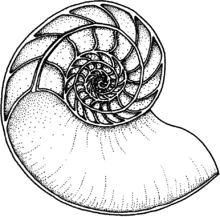Siphuncle

The siphuncle is a strand of tissue passing longitudinally through the shell of a cephalopod mollusk. Only cephalopods with chambered shells have siphuncles, such as the extinct ammonites and belemnites, and the living nautiluses, cuttlefish, and Spirula. In the case of the cuttlefish, the siphuncle is indistinct and connects all the small chambers of that animal's highly modified shell; in the other cephalopods it is thread-like and passes through small openings in the walls dividing the chambers.
The siphuncle is used primarily in emptying water from new chambers as the shell grows.[1] Essentially what happens is the cephalopod increases the saltiness of the blood in the siphuncle, and the water moves from the more dilute chamber into the blood through osmosis. At the same time gas, mostly nitrogen, oxygen, and carbon dioxide, diffuses from the blood in the siphuncle into the emptying chamber. Note that the cephalopod does not pump up the shell; the gas moving into the chamber is a passive process, instead the energy is used in absorbing the water from the chamber.

Removing water from the chambers of the shell reduces the overall density of the shell, and thus the shell behaves as a flotation device comparable to the swim bladder in bony fish. Typically, cephalopods maintain a density close to that of sea water, allowing them to swim with the minimum of effort. In the geologic past, many cephalopods grew to an enormous size (perhaps approaching ten meters in length) thanks to this.
Generally, the siphuncle is unable to provide a way to change the density of shell rapidly and thus cause the animal to rise or sink at will; rather, the animal must swim up or down as required.
The siphuncle found in fossilised cephalopods is assumed to have worked in the same general way. The siphuncle itself only rarely gets preserved, but many fossils show the holes, called septal necks (or siphuncle notches), through which the siphuncle passed. In most fossil nautiluses, the siphuncle runs more or less through the center of each chamber, but in ammonites and belemnites it usually runs along the ventral surface. In some fossil straight shelled nautiluses cylindrical calcareous growths ("siphuncular deposits") around the siphuncle can be seen towards the apex of the shell. These were apparently counterweights for the soft body at the other end of the shell, and allowed the nautilus to swim in a horizontal position. Without these deposits, the apex of the buoyant shell would have pointed upwards and the heavier body downwards, making horizontal swimming difficult. The siphuncle of the Endocerida also contained much of the organisms' body organs.[2]
See also
References
- ↑ Mutvei, Harry; Zhang, Yun-bai; Dunca, Elena (2007). "Late Cambrian Plectronocerid Nautiloids and Their Role in Cephalopod Evolution". Palaeontology. 50 (6): 1327–1333. doi:10.1111/j.1475-4983.2007.00708.x.
- ↑ Kroger, B; Yun-Bai, Zhang (2008). "Pulsed cephalopod diversification during the Ordovician". Palaeogeography Palaeoclimatology Palaeoecology. 273: 174. doi:10.1016/j.palaeo.2008.12.015.


